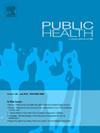‘Family Matters’: A multilevel analysis of household-level clustering of overweight and obesity among adults in India
IF 3.9
3区 医学
Q1 PUBLIC, ENVIRONMENTAL & OCCUPATIONAL HEALTH
引用次数: 0
Abstract
Objectives
To examine the clustering of overweight and obesity among adults within Indian households.
Study design
Nationally representative cross-sectional study.
Methods
Data from the fifth round of the National Family Health Survey (NFHS-5, 2019-21) were analyzed to assess the prevalence of overweight and obesity among adults aged 15–54 years. The study encompassed 636,699 households and 761,885 individuals. Households were categorized based on the presence of overweight or obese members, and multilevel logistic regression was used to evaluate variations at the household, community, district, and regional levels.
Results
Nearly 20 % (95 % CI:19.1–19.5) of households in India had all adults classified as overweight, and 10 % (95 % CI:9.4–9.7) had all adults classified as obese. In states, such as Manipur, Kerala, Arunachal Pradesh, and Sikkim, over 30 % of households had all adults overweight. Additionally, in Tamil Nadu and Punjab, two out of every five households had all adults classified as obese. Among the households belonging to the richest wealth quintile, one in four had all members overweight, and 17.3 % (95 % CI:16.8–17.7) had all members classified as obese. The proportion of households with all obese members was nearly twice as high in urban areas (14.3–15.0 %) compared to their rural counterparts (7.1–7.4 %). Households belonging to Scheduled Tribes reported the lowest proportion of households with all members classified as obese, at only 4.2% (95% CI: 3.9–4.5), while households belonging to forward ('others') social group recorded the highest proportion, at 12.2% (95% CI: 11.8–12.5).
Conclusion
The clustering of overweight and obesity within households, particularly in southern states, among affluent populations, and in urban settings, underscores the importance of family-centered approaches to obesity prevention and intervention.
“家庭问题”:印度成年人超重和肥胖家庭水平聚类的多层次分析
目的研究印度家庭中成年人超重和肥胖的聚类情况。研究设计全国代表性横断面研究。方法分析第五轮全国家庭健康调查(NFHS-5, 2019-21)的数据,评估15-54岁成年人超重和肥胖的患病率。这项研究包括636,699个家庭和761,885个人。根据超重或肥胖成员的存在对家庭进行分类,并使用多水平逻辑回归来评估家庭、社区、地区和区域层面的变化。结果在印度,近20% (95% CI: 19.1-19.5)的家庭将所有成年人归类为超重,10% (95% CI: 9.4-9.7)的家庭将所有成年人归类为肥胖。在曼尼普尔邦、喀拉拉邦、**邦和锡金等邦,超过30%的家庭成年人都超重。此外,在泰米尔纳德邦和旁遮普邦,每五个家庭中就有两个家庭的所有成年人都被列为肥胖。在最富有的五分之一家庭中,四分之一的家庭成员都超重,17.3% (95% CI: 16.8-17.7)的家庭成员都被列为肥胖。所有成员都肥胖的家庭比例在城市地区(14.3 - 15.0%)几乎是农村地区(7.1 - 7.4%)的两倍。属于表列部落的家庭报告的所有成员被归类为肥胖的家庭比例最低,仅为4.2% (95% CI: 3.9-4.5),而属于向前(“其他人”)社会群体的家庭记录的比例最高,为12.2% (95% CI: 11.8-12.5)。结论超重和肥胖在家庭中的聚集性,特别是在南方各州、富裕人群和城市环境中,强调了以家庭为中心的肥胖预防和干预方法的重要性。
本文章由计算机程序翻译,如有差异,请以英文原文为准。
求助全文
约1分钟内获得全文
求助全文
来源期刊

Public Health
医学-公共卫生、环境卫生与职业卫生
CiteScore
7.60
自引率
0.00%
发文量
280
审稿时长
37 days
期刊介绍:
Public Health is an international, multidisciplinary peer-reviewed journal. It publishes original papers, reviews and short reports on all aspects of the science, philosophy, and practice of public health.
 求助内容:
求助内容: 应助结果提醒方式:
应助结果提醒方式:


